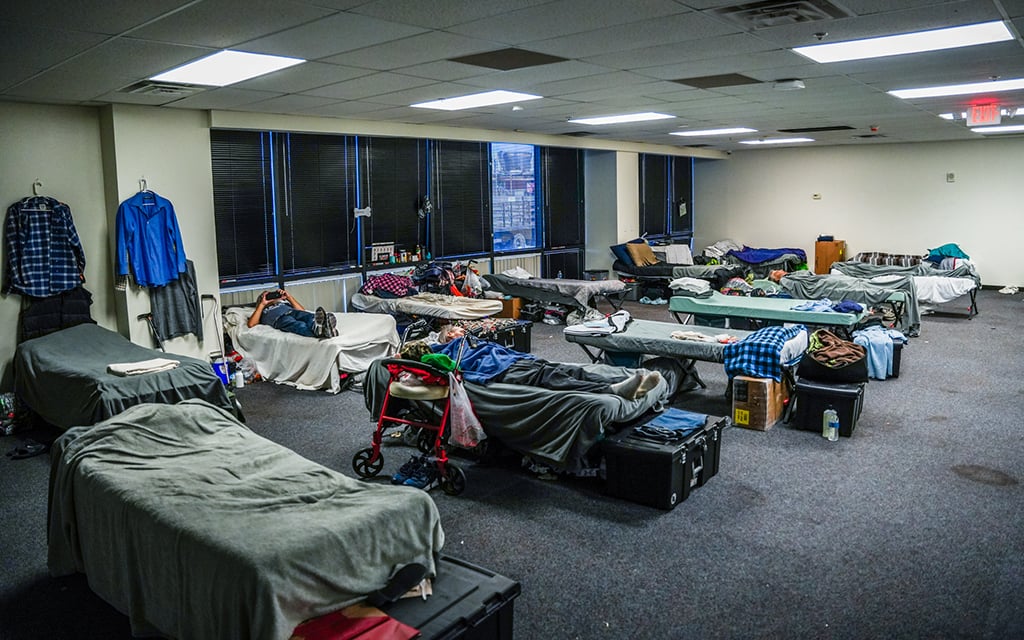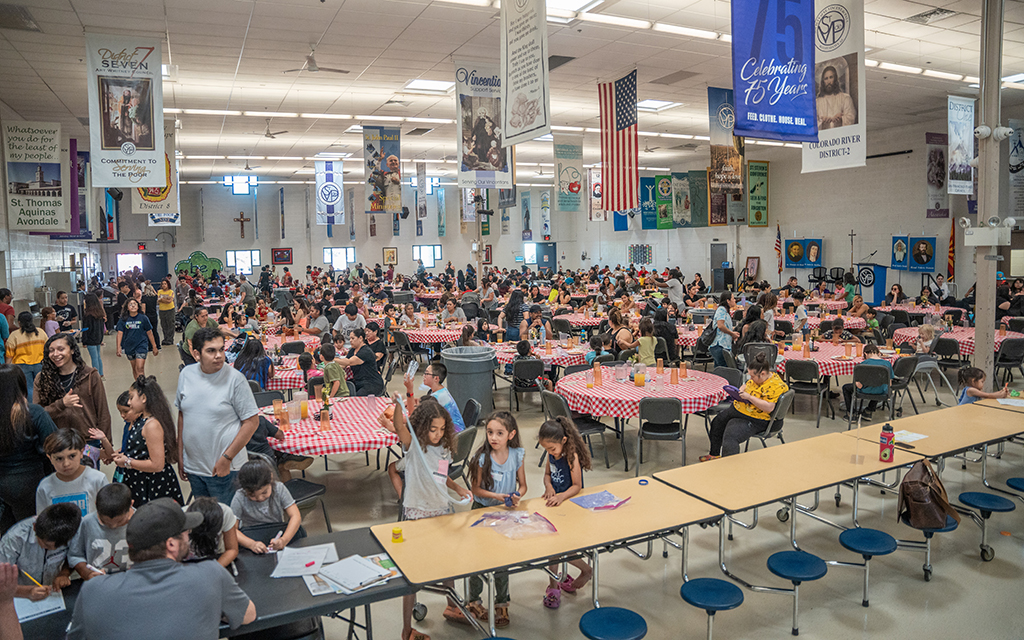
People who are experiencing homelessness are provided with beds at St. Vincent de Paul’s Washington Street Shelter. (Photo courtesy of St. Vincent de Paul)
PHOENIX – The Valley of the Sun is no stranger to heat, as the bustling metropolis experienced record-breaking temperatures last year. The heat made international headlines, with the city experiencing 133 days of over 100-degree weather. This heat, driven by climate change, is likely to alter how Phoenicians spend time outdoors. For those who are experiencing homelessness, it’s a more serious matter entirely.
According to the 2023 Point-In-Time Homelessness Count, there were 9,642 unhoused individuals in Maricopa County on Jan. 23, 2023, about half of whom had some form of shelter. That was up from 9,026 in 2022 and up sharply from 7,419 in 2020. No count was done in 2021 because of the COVID-19 pandemic.
St. Vincent de Paul is among the organizations in Phoenix that provide solutions for unhoused people. Its community shelters offer beds, clothing and food to everyone they can. In the summer, the organization offers bottled water, indoor air conditioning and outdoor heat relief stations.
Jessica Berg, the organization’s chief program officer, explained how the extreme temperatures, COVID-19 and bed shortages impacted their interaction with people seeking shelter.
“It (heat) can be very devastating. … Last year in Maricopa County, there were 579 heat-associated deaths,” said, Berg, and almost half were confirmed to be homeless individuals, according to Maricopa County Department of Public Health data. “Last summer, there were many tents outside the Human Services Campus, and I think that during COVID, the public health advice was: ‘People are safer outside.’ And so, I think that’s how we got to where we were as a community, that we just had more and more people who were outside, and we didn’t have enough shelter beds.”
Last November, the city cleared out the 15-block outdoor encampment known as “The Zone” near downtown Phoenix. There were nearly 1,000 unhoused individuals there. The city offered services to 718 people, and 585 accepted housing placement, potentially averting another summer condition of hundreds of tents packed in extreme heat.

Seniors, veterans and people with disabilities stay at Ozanam Manor, a St. Vincent de Paul transitional shelter. (Photo courtesy of St. Vincent de Paul)
“The goal in the summer is to get people inside as quickly as possible,” Berg emphasized.
Berg said evictions are one reason why more people are homeless. She said the city has worked more in the last year to provide shelters with new beds to keep up with this rise. Despite the state implementing an eviction moratorium from March to October 2020, eviction filings were back above pre-pandemic levels by March 2022 and have largely remained there since. There were 83,236 filings this past year, up 30% over an average year pre-pandemic, according to Princeton University’s Eviction Lab.
Autumn Blackwell, St. Vincent de Paul interim operations manager at Washington Street Shelter, said the organization’s Washington Street Shelter and City Center experienced an influx of people due to evictions.
“For a lot of our people, our next step is just taking care of those old evictions from the pandemic,” Blackwell said.
The organization’s Housing 2025 plan aims to provide permanent housing for 2,025 people by 2025. As of January, 1,685 people had been provided permanent homes through the plan.
Aside from beds, Berg said the organization provides other relief for summer weather.
“We do significant water drives. We’re giving out about 7,000 bottles of water a day, and that’s the first line of defense against the heat. We have extended hours in all of our dining rooms and (are) just trying to make sure that folks are in air conditioning as much as possible,” Berg said.
Berg said a partnership with the city allowed the organization to operate heat relief stations to cover more ground.

The NextPhase Family Dining Room at St Vincent de Paul’s main campus serves meals to families with children 18 and under. (Photo courtesy of St. Vincent de Paul)
While the Valley is a few months away from summer weather, as of now, the colder temperatures can also prove difficult for those without shelter.
“It’s a lot nicer if you’re unsheltered right now to be out in the streets. But we still have (had) those weeks where it’s below freezing at night, and it doesn’t get higher than 45 to 50 degrees – 55 degrees during the day. It’s still chilly for people to be just out there all the time, especially if they have some health conditions.” Blackwell said.
Both Berg and Blackwell said that much of St. Vincent de Paul’s accomplishments are thanks to community efforts.
“A lot of nonprofits will say that they’re ‘tackling’ poverty or ‘fighting’ poverty or ‘fighting’ hunger. We try not to fight. We really think more about bringing people together to wrap our arms around the solution,” Berg said.
Blackwell pointed to rising income disparities among the retirement-age population posing a significant challenge in the coming years. St. Vincent de Paul is in the process of building more transitional housing for seniors, with 100 new beds.
“We have a lot of people who are seniors. And, unfortunately with the housing crisis, they just don’t have places to go because of how expensive it is and their fixed income. I think that potentially could get worse in the next couple of years. That’s something I hope we can try to solve,” Blackwell said.
What's Working
-
Urban farm provides homeless shelter residents with good food and opportunities
An innovative partnership between Bell Shelter, a homeless shelter, Grow Good, an urban farm, and the Salvation Army is bringing healthy food and cooking to a new audience in Los Angeles. People experiencing homelessness are able to get paid to learn culinary skills, and the food from the urban garden both feeds the homeless residents as well as earns income through a social enterprise model that helps fund the training and support programming. After shelter clients participate in the 12 week culinary training program, many are able to get full-time jobs at local culinary institutions.Read Full Story
